因为面试的时候总是被问到有没有了解过跨平台,所以趁着有时间了解了一下rn,做了个简单的demo
界面如下,首先是一个登陆页面,然后跳转到一个tabbar集成的界面中,我的界面点击退出登录,可以回到登录页面

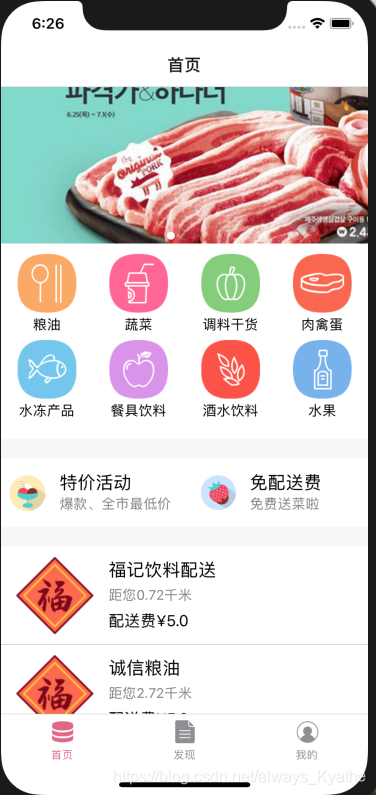

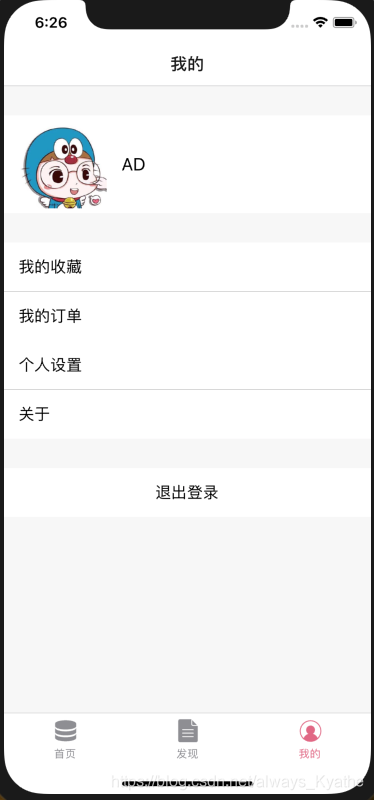
tabbar集成的页面是FirstPage.js / SecondPage.js / ThirdPage.js 总的AppNavigator.js,用到了createStackNavigator 和集成tabbar的createBottomTabNavigator
const AppBottomNavigator=createBottomTabNavigator({
FirstPage:{
screen:FirstPage,
navigationOptions: {
title:'首页',
tabBarLabel: '首页',
tabBarIcon: ({tintColor, focused}) => {
return <Image
source={require('./pictures/ic_sheet_tab.png')}//自定义图片
style={{width:26,height:26, tintColor: tintColor}}//选中后颜色变成tintcolor
/>
}
}
},
SecondPage:{
screen:SecondPage,
navigationOptions:{
title:'发现',
tabBarLabel:'发现',
tabBarIcon:({tintColor,focused})=>{
return <Image
source={require('./pictures/ic_tab_document.png')}//自定义图片
style={{width: 26,height:26,tintColor:tintColor}}//选中后颜色变成tintcolor
/>
}
}
},
ThirdPage:{
screen:ThirdPage,
navigationOptions:{
title :'我的',
tabBarLabel:'我的',
tabBarIcon:({tintColor, focused})=>{
return <Image
source={require('./pictures/ic_tab_me.png')}
style={{width:26,height:26,tintColor:tintColor}}
/>
}
}
},
},{
tabBarOptions:{
activeTintColor:'#e36784'
}
});
export const AppStackNavigator=createStackNavigator({
// FirstPage:{
// screen:FirstPage,
// navigationOptions:({navigation})=>({
// // title: 'FirstPage',
// header:null
// }),
//
// },
// SecondPage:{
// screen:SecondPage,
// navigationOptions:({navigation})=>({
// title:'SecondPage'
// }),
// },
// ThirdPage:{
// screen:ThirdPage,
// navigationOptions:({navigation})=>({
// title:'Third'
// })
// },
Bottom:{
screen:AppBottomNavigator,
navigationOptions:{
title:'hh',
// header:null,
headerLeft:null,//隐藏左侧返回按键
}
},
});想要让每个tab页的标题和底部tabbarlabel的标题一致,需要如下代码,从而实现可以对具体页的导航栏标题进行修改
AppBottomNavigator.navigationOptions=({navigation})=>{//可以对具体页的导航栏标题进行修改
let {routeName} = navigation.state.routes[navigation.state.index];
if (routeName ==='FirstPage'){
return {
headerTitle:'首页'
// header:null
}
} else if (routeName==='SecondPage'){
return {
headerTitle:'发现'
}
} else if (routeName === 'ThirdPage'){
return {
headerTitle:'我的'
}
}
};登陆页面是LoginPage.js
【这里要更正一下,一开始把loginpage也写进了createStackNavigator里面,后来发现,首页竟然能返回到登陆页面,这不是我们想要的。所以应该改用createSwitchNavigator,它的用途是一次只显示一个页面,默认情况下,不处理返回操作,适用于登陆界面,官网有createSwitchNavigator的示例
import React from 'react';
import {
ActivityIndicator,
AsyncStorage,
Button,
StatusBar,
StyleSheet,
View,
} from 'react-native';
import { createStackNavigator, createSwitchNavigator, createAppContainer } from 'react-navigation';
class SignInScreen extends React.Component {
static navigationOptions = {
title: 'Please sign in',
};
render() {
return (
<View style={styles.container}>
<Button title="Sign in!" onPress={this._signInAsync} />
</View>
);
}
_signInAsync = async () => {
await AsyncStorage.setItem('userToken', 'abc');
this.props.navigation.navigate('App');
};
}
class HomeScreen extends React.Component {
static navigationOptions = {
title: 'Welcome to the app!',
};
render() {
return (
<View style={styles.container}>
<Button title="Show me more of the app" onPress={this._showMoreApp} />
<Button title="Actually, sign me out :)" onPress={this._signOutAsync} />
</View>
);
}
_showMoreApp = () => {
this.props.navigation.navigate('Other');
};
_signOutAsync = async () => {
await AsyncStorage.clear();
this.props.navigation.navigate('Auth');
};
}
class OtherScreen extends React.Component {
static navigationOptions = {
title: 'Lots of features here',
};
render() {
return (
<View style={styles.container}>
<Button title="I'm done, sign me out" onPress={this._signOutAsync} />
<StatusBar barStyle="default" />
</View>
);
}
_signOutAsync = async () => {
await AsyncStorage.clear();
this.props.navigation.navigate('Auth');
};
}
class AuthLoadingScreen extends React.Component {
constructor() {
super();
this._bootstrapAsync();
}
// Fetch the token from storage then navigate to our appropriate place
_bootstrapAsync = async () => {
const userToken = await AsyncStorage.getItem('userToken');
// This will switch to the App screen or Auth screen and this loading
// screen will be unmounted and thrown away.
this.props.navigation.navigate(userToken ? 'App' : 'Auth');
};
// Render any loading content that you like here
render() {
return (
<View style={styles.container}>
<ActivityIndicator />
<StatusBar barStyle="default" />
</View>
);
}
}
const styles = StyleSheet.create({
container: {
flex: 1,
alignItems: 'center',
justifyContent: 'center',
},
});
const AppStack = createStackNavigator({ Home: HomeScreen, Other: OtherScreen });
const AuthStack = createStackNavigator({ SignIn: SignInScreen });
export default createAppContainer(createSwitchNavigator(
{
AuthLoading: AuthLoadingScreen,
App: AppStack,
Auth: AuthStack,
},
{
initialRouteName: 'AuthLoading',
}
));】
注:可以通过
navigationOptions={
header:null,//隐藏导航栏
};隐藏导航栏
用StyleSheet声明样式
在render()函数中进行界面的布局,考虑到适配iPhone X,所以在布局前,先定义一个
<SafeAreaView style={{flex:1,backgroundColor:'#f5fcff'}}> </SafeAreaView> 所有的界面布局都写在safeAreaView里面。flex为1指定组件扩张以充满所有剩余的空间。
关于布局属性,比较常用的几个 :
flexDirection 表明主轴方向,即子元素沿哪个方向布局
alignItems表明子元素沿次轴方向的排列方式
alignSelf表明具体元素在次轴方向的排列方式,可以覆盖alignItems
justifyContent表明子元素沿着主轴方向的排列方式,是靠近主轴起始段还是末尾段,还是均匀分布...
所以登陆页面的背景view声明 flexDirection:'column'
头像居中,所以声明 alignSelf:'center'
无法登陆和新用户放置在一个view里,设置 justifyContent: 'space-between'//主轴两端对齐 所以这两个按键可以在左右两端
其他登陆方式和两个图标房子一个view里,设置 justifyContent:'flex-start', flexDirection:'row'//内部控件水平排列 所以这三个组件从界面的左边开始向右排列
为登陆按键添加点击事件,可以跳转到tabbar
<TouchableOpacity
style={styles.button}
onPress={()=>{
navigation.navigate('Bottom')
}}
>
<Text style={styles.loginText}>登录</Text>
</TouchableOpacity>接下来是首页
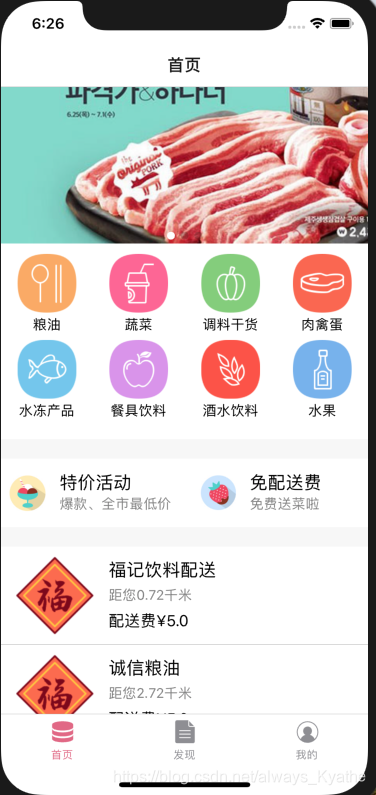
可以通过
static navigationOptions ={
headerLeft:null,//隐藏左侧返回按键
// title:'首页'
};隐藏左侧的返回按键
界面的最上面部分是一个轮播图 ,用到的组件是Swiper 最下面是表格,用到的是Flatlist,因为可能界面一开始显示不完所有组件,所以用一个大的scrollview包裹所有组件
发现界面用的是Flatlist
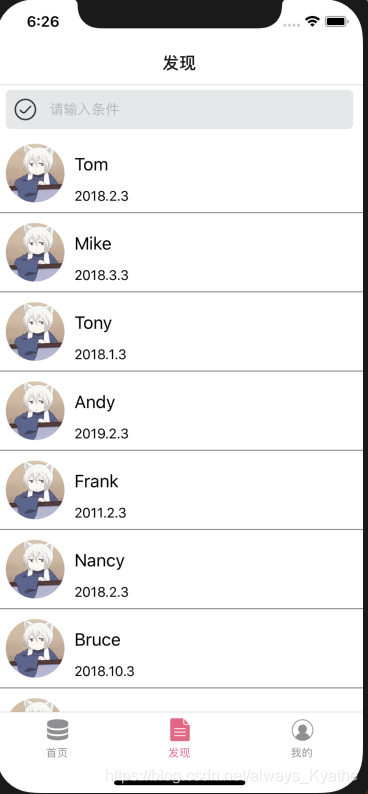
export default class SecondPage extends Component<Props>{
static navigationOptions ={
headerLeft:null,//隐藏左侧返回按键
title:'发现'
};
_flatList;
_renderItem=(item)=>{//渲染数据
return (
<TouchableOpacity style={styles.itemView}>
<Image
source={require('./pictures/bawei.png')}
style={styles.itemImg}
/>
<View style={styles.itemTextView}>
<Text style={styles.itemText}>
{item.item.title}
</Text>
<Text style={styles.itemDetail}>
{item.item.detail}
</Text>
</View>
</TouchableOpacity>
)
};
_separator=()=>{//分隔线
return <View style={{height:1,backgroundColor:'gray'}}>
</View>
};
render(){
var data = [// 数据源
{
title:'Tom',
detail:'2018.2.3'
},{
title:'Mike',
detail:'2018.3.3'
},{
title:'Tony',
detail:'2018.1.3'
},
{
title:'Andy',
detail:'2019.2.3'
},{
title:'Frank',
detail:'2011.2.3'
},{
title:'Nancy',
detail:'2018.2.3'
},{
title:'Bruce',
detail:'2018.10.3'
},{
title:'Tom',
detail:'2018.12.3'
},{
title:'Ann',
detail:'2018.2.3'
}
];
return(
<SafeAreaView style={{flex:1,backgroundColor:'white'}}>
<View style={styles.container}>
<View style={styles.searchBgView}>
<Image
style={styles.searchImg}
source={require('./pictures/tick.png')}
/>
<TextInput
style={styles.searchInputText}
// style={{marginLeft:10,paddingRight: 50}}// 距父控件右边界的距离用paddingright
placeholder='请输入条件'
/>
</View>
<View ItemSeperatorComponent={this._separator}/>
<View style={{flex:1,marginTop:5}}>
{/*//加了flex之后会考虑底部安全距离*/}
<FlatList
ref = {(flatList)=>this._flatList = flatList}
ItemSeparatorComponent={this._separator}
renderItem={this._renderItem}
data={data}
keyExtractor={(item,index)=>index.toString()}
// 每个cell一个独一无二的key值,加上toString()后不警告
>
</FlatList>
</View>
</View>
</SafeAreaView>
)
}
}接下来介绍个人中心界面
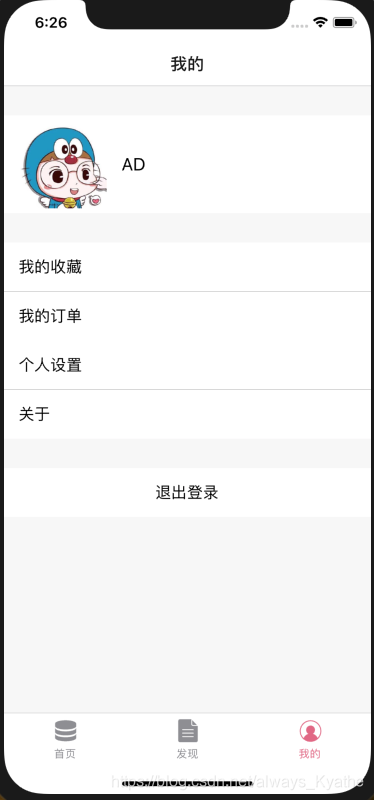
因为列表分为三个section,所以用Sectionlist组件,因为不同的section有不同的样式,所以在每个数组里分别为renderItem进行赋值
export default class ThirdPage extends Component<Props>{
static navigationOptions ={
headerLeft:null,//隐藏左侧返回按键
title:'我的'
};
_renderItem=(item)=>{//渲染数据,第二个section
return (
<TouchableOpacity style={styles.itemView}>
<Text style={{marginLeft: 15,fontSize: 16}}>
{item.item.title}
</Text>
</TouchableOpacity>
)
};
_renderItem1=(item)=>{//渲染数据,第一个section
return (
<TouchableOpacity style={styles.imgView}>
<Image
style={{marginLeft:15,width:90,height:90}}
source={require('./pictures/pic.png')}
/>
<Text style={{marginLeft: 15,fontSize: 18}}>
{item.item.title}
</Text>
</TouchableOpacity>
)
};
_renderItem2=(item)=>{//渲染数据,第三个section
return (
<TouchableOpacity style={styles.itemV}
onPress={()=>this.props.navigation.navigate('LoginPage')}
// 注册事件,退出登录,navigate回到起始登录页面
>
<Text style={{fontSize: 16}}>
{item.item.title}
</Text>
</TouchableOpacity>
)
};
_sectionItem=(item)=>{
return (
<View style={{height:30,backgroundColor:'#f7f7f7'}}>
</View>
)
};
_separator=()=>{//分隔线
return <View style={{height:0.2,backgroundColor:'gray'}}>
</View>
};
render() {
var sections = [// 数据源,因为不同的section有不同的样式,所以在每个数组里分别为renderItem进行赋值
{key:'0',
data:[{img:'./pic.png', title:'AD'}],
renderItem:this._renderItem1
},{key:'1',
data:[{title:'我的收藏'},{title:'我的订单'},{title:'个人设置'},{title:'关于'}],
renderItem:this._renderItem
},{key:'2',
data:[{title:'退出登录'}],
renderItem:this._renderItem2
}];
return(
<SafeAreaView style={{flex:1,backgroundColor:'#f7f7f7'}}>
<View style={styles.container}>
<SectionList
renderSectionHeader={this._sectionItem}// 每个section的头
sections = {sections}
ItemSeparatorComponent={this._separator}// 分割线
keyExtractor={(item,index)=>index.toString()}
>
</SectionList>
</View>
</SafeAreaView>
)
}
}现在修改了“发现”界面,因为想要实现
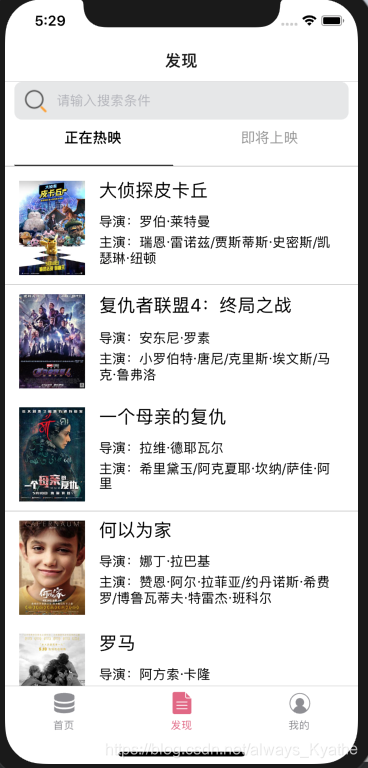
横向的滚动视图效果,百度后发现是要用react-native-scrollable-tab-view
首先添加react-native-scrollable-tab-view
npm install react-native-scrollable-tab-view --save然后需要import相应组件
import ScrollableTabView, {DefaultTabBar, } from 'react-native-scrollable-tab-view';相关代码如下
<ScrollableTabView
renderTabBar={() => <DefaultTabBar/>}// 系统提供
tabBarUnderlineStyle={{
backgroundColor: '#000',
height: 1,
width: '45%',
marginLeft: 10,
marginRight: 10,
}}
tabBarBackgroundColor='#ffffff'
tabBarActiveTextColor='#000'
tabBarInactiveTextColor='#959595'
tabBarTextStyle={{fontSize: 15, textAlignVertical: 'center'}}
locked={false}
>
{/*几个view就有几个滑动页面,tabLabel就是标题名*/}
<View tabLabel='正在热映'
style={{flex:1,marginTop:5}}>
{/*//加了flex之后会考虑底部安全距离*/}
<FlatList
ItemSeparatorComponent={this.separator}
data = {movies}
renderItem={this.renderItem}
handleMethod = {({viewableItems}) => this.handleViewableItemsChanged(viewableItems)}
keyExtractor={(item,index)=>index.toString()}
// 每个cell一个独一无二的key值,加上toString()后不警告
>
</FlatList>
</View>
<View tabLabel='即将上映'
style={{flex:1,marginTop:5}}>
{/*//加了flex之后会考虑底部安全距离*/}
<FlatList
ItemSeparatorComponent={this.separator}
data = {comings}
renderItem={this.renderItem}
handleMethod = {({viewableItems}) => this.handleViewableItemsChanged(viewableItems)}
keyExtractor={(item,index)=>index.toString()}
// 每个cell一个独一无二的key值,加上toString()后不警告
>
</FlatList>
</View>
</ScrollableTabView>github地址:https://github.com/yathe/firstRNProject




 作者因面试常被问跨平台,遂了解RN并做简单Demo。介绍了登录页、tabbar集成页等界面,涉及导航栏标题修改、布局属性设置、组件使用等,如用createSwitchNavigator处理登录页,用Swiper做轮播图等,还给出了github地址。
作者因面试常被问跨平台,遂了解RN并做简单Demo。介绍了登录页、tabbar集成页等界面,涉及导航栏标题修改、布局属性设置、组件使用等,如用createSwitchNavigator处理登录页,用Swiper做轮播图等,还给出了github地址。
















 636
636

 被折叠的 条评论
为什么被折叠?
被折叠的 条评论
为什么被折叠?








